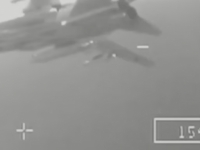Politics
NATO Baltic Air Policing intercepted Russian firghters over a US Navy destroyer
Alliance conduct live-fly flights
USPA NEWS -
Belgian jets assigned to NATO's Baltic Air Policing mission intercepted Russian firghters as they conducted low passes over a US Navy destroyer. The Belgian F-16 Fighting Falcon multirole fighters launched from Siauliai Air Base in Lithuania, where the air policing mission is headquartered, informed the Alliance on Thursday.
The Belgian jets intercepted the Russian aircraft ““ two Su-24 Fencer attack jets, one Su-27 Flanker air superiority fighter and one Su-30 Flanker-C multirole fighter ““ over the USS Donald Cook, an Arleigh Burke-class destroyer manoeivring in the Baltic Sea off the coast of Lithuania. “The F-16s conducted the intercept in a safe and professional manner,“ NATO says. Air policing is a peacetime activity conducted 365 days a year over Alliance territory. Intercepts can be triggered when an aircraft ““ civilian or military ““ does not respond to hails from air traffic controllers.
Also on April 20 and 21, air forces from four Allies and two Partners and a NATO E-3A AWACS plane conducted live-fly training flights in segregated training areas and international airspace over the Baltic Sea. The goal of Exercise Ramstein Alloy 20-1 is to practice procedures and coordination processes among Allies and Partners. Belgium and Poland F-16 fighter aircraft, as well as Lithuania C-27 transport aircraft and a SAR helicopter, German Eurofighter aircraft and an A400M air-to-air refueler operated with Finnish F-18 and Swedish JAS-39 fighters during several scenarios. All aircraft deployments and missions were controlled by the Control and Reporting Centres at Karmelava and Tallinn; a NATO AWACS plane also controlled Polish and German fighters and Belgian and Swedish fighters during their air-to-air combat training.
All participants are flying in from their home bases: Belgian F-16 and Lithuanian aircraft from Siauliai, Lithuania; Polish F-16 from Ämari, Estonia; German Eurofighters and A400M transport aircraft from Germany, and Finnish and Swedish fighters from their respective bases.
On day 1 the central scenario was one that occurs frequently in the airspace over all Allies ““ a COMLOSS situation where a pilot of an aircraft loses communications with civilian Air Traffic Control. The Lithuanian C-27 transport aircraft simulated such a plane while transiting from Estonian into Finnish airspace. This triggered the response and coordination processes required to handle such an event from registering the COMLOSS aircraft, to launching the fighters and intercepting, identifying and handing over the plane. Finnish F-18 and Polish F-16 fighters conducted this trainings.
During a simulated crew ejection with activation of the Search and Rescue chain, a Belgian F-16 was “rescued“ by a Lithuanian Mi-8 SAR helicopter; the German A400M conducted air-to-air refuelling with German Eurofighters and Belgian and Swedish jets executed a practice diversion with fly-by over Siauliai Air Base, Lithuania.
“It was a perfect execution of our collective plans,“ said the Ramstein Alloy leader planner at the Combined Air Operations Centre in Uedem, Germany. “We virtually flew all our sorties and achieved all the objectives, making this first day of the exercise a full success,“ he added.
Liability for this article lies with the author, who also holds the copyright. Editorial content from USPA may be quoted on other websites as long as the quote comprises no more than 5% of the entire text, is marked as such and the source is named (via hyperlink).






